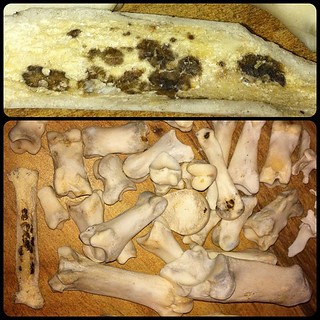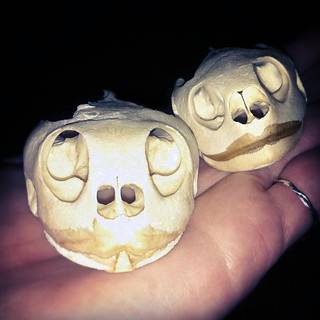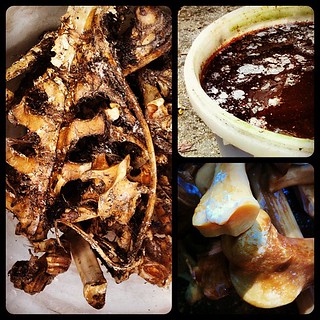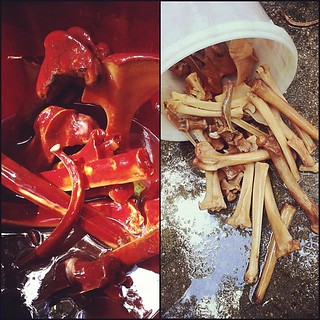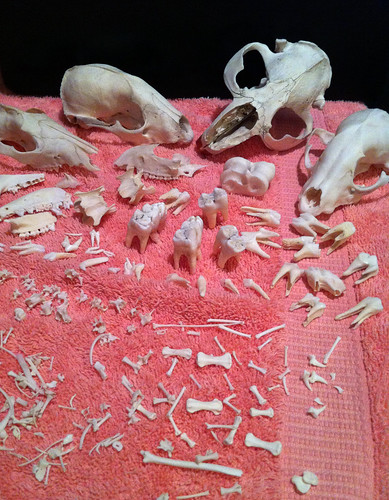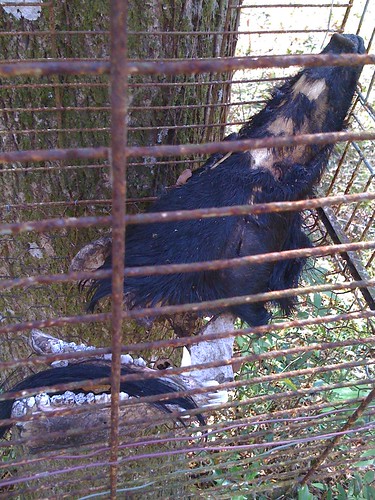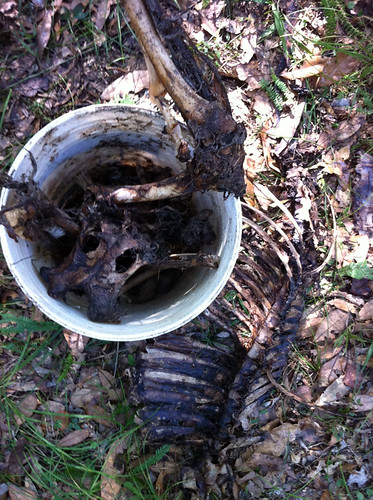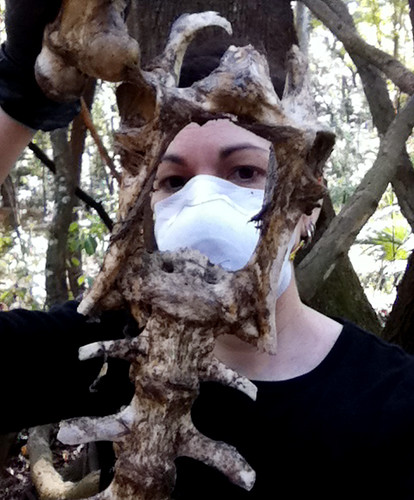
-----
I did this second interview below with Newsweek in April/May of 2018 and it never went to print for unknown reasons. Some of the things we talked about are no longer relevant. So I added those edits to this in italics. This would probably have been significantly edited as most interviews are. Especially since this is so very long because I kept being asked additional questions as this interview evolved. So, here is the whole thing in Q&A form for anyone that really wants to know more about me and how BoneLust came about to be.
Cats and bones are a common sight at BoneLust Studio. This is Luci with equine skulls.
1. What do you refer to yourself as in your line of work?
As a lifelong collector of found objects, especially those from nature, I like to think of myself as a natural history artist and collector. My business card says - Ethical Bone & Taxidermy Artist. I’ve been called a lot of things though, a favorite is “the ultimate recycler”.
2. How did you get into processing animal remains? Why do you like it? Is it your main source of income?
I grew up in a very nature oriented family. I could go as far as to saying we are naturalists. My parents, John and Mary, are also here in Florida. My mother worked for years in recycling and these days has had much success in bringing back the troubled Eastern Bluebird population, with her Audubon work. My father is a retired hydrogeologist that had his start in the Peace Corps, turned writer of speculative fiction. Our family has always been heavily involved in native plants and wildlife here in Florida. So, I grew up admiring and respecting the natural world, always curious to learn more. I would find dead creatures around our home or bring them home from family beach outings like starfish, sand dollars, and horseshoe crabs. This is where my learning process began for the preservation of these kinds of creatures.
I love the whole process involved in starting off with a dead creature and seeing what I can do to salvage it… and how nature can help, like carrion insects. I learned to identify what different animal species skeletons look like from processing them myself. I love the science involved in these processes as well. I do a lot of experimentation and am always learning new things. There is a lot of satisfaction for me in taking a found deceased animal and making something beautiful to honor their life. It does not always have to be art. Sometimes it is just the cleaned skull. But a favorite is my Token From The Heart series where I use a self taught process to dry preserve the heart. Then use it in jewelry or displays. A fairly literal representation of honoring life after death.
This is a full time job for me and my only income. Well to be technical, I find and process most of the animals used in my art and jewelry. I started using bones and other dead things in my art and jewelry back in the 1980s. In the early 1990s I first used real human teeth in jewelry. I also do Pet Memorial processing work these days. This was something I only did for years for friends before receiving overwhelming requests from the public. Once I felt fully comfortable with my skills I offered these service to mourning pet families here in the US. There is no higher honor for me than this.

Token From The Heart series dry preserved animal heart pendant necklaces by BoneLust.

Token From The Heart series dry preserved animal heart pendant necklaces by BoneLust.
3. Do you have any significant experience that you might like to share, like your first experience with processing remains, or the first dead animal you found?
One day my older brother, Chris, and I were exploring the neighborhood when we came across a tiny mummified hatchling turtle being devoured in an ant pile. I recall arguing over who was going to get to keep it. With me being only 7, and he being 10, of course he won. That was the moment that got me fascinated with what’s inside an animal, inside us that makes us alive.. and what happens when it all stops. My brother and I had a collection in his room for years that was our own natural history museum. I coveted that turtle for a long time and he finally passed it onto me when I was 23. It wasn’t just a dead turtle to me, it meant much more.
Another time we found a massive dead shark on a beach and our parents were less than happy that we ran up to it and were trying to pull the teeth out!
Here’s your funny story! After one family trip, I brought home countless sadly dead starfish that I found on a beach. My plan was to somehow preserve them. If only I knew then what I know now! I BOILED them and made a massive nasty smelling pot of rotten starfish stew. Yuck! One of the worst smells. I was pretty young so who knows my logic behind this. Everything I know now I taught myself from mistakes like this. Years before you could ask the internet how. Before there were even books on the topic.
Another significant bit of info. My family had a pet cemetery garden in the back yard where we said goodbye together to our cats that passed. I had my own personal mini cemetery as well in a different part of the yard that I buried anything that I found dead - lizards, toads, frogs, mice, insects, etc. I don’t think anyone else knew about it. But I found comfort in this ritual. A way to deal with death as a child. My family has always been very open about death. In my early teens my rat, Louie, had to be put to sleep because of a tumor. Louie was the first pet memorial processing I did. I don’t think it was even planned this way. I just wanted to know what his skull looked like. I still have it lovingly at my work desk. Fast forward a lifetime of experience, I now do pet memorial processing as a large part of my income.

Self portrait of the bone artist, Jana Miller.
4. Is there any sort of timeline that can help explain how and why bone collecting and taxidermy gained popularity?
I assume you are asking about this modern resurrection. But what comes to mind is how the cabinets of curiosities in the 18th-19th centuries in particular created today’s Natural History Museums. That age of rampant natural history collecting spurred some of our much needed animal parts laws to come to be. Like the Migratory Bird Treaty Act, with the decimation of bird populations all over the world due to these trends in collecting and fashion.
The last time there was such a massive public boom of interest in natural history collecting, was then. However, I believe that it was the television show “Oddities” that brought back to the public eye natural history collecting and art. It began in November of 2010. At that time I coincidentally was already making regular posts to my bone processing and collecting blog, Bonelust, that I made public in April of 2009. So it seemed like a sign to me, that my desire to take my lifelong hobby one step forward to a full time business, was a good one to follow through on.
I grew up being fairly secretive about my bone processing with friends, and family. Back then it was not as mainstream acceptable or trendy and instead very highly looked down upon. Sick and freak were very degrading things to be called then… complete opposite these days! Which I honestly still am trying to get past that stigma sometimes. While I am very well know and respected now in certain circles. I still don’t tell most strangers that I meet what I really do for a living.

5. Do you have any ethical concerns about the growing community?
Absolutely. With the rise in animal remains in jewelry and art being a trend now, of course many people see this as an opportunity to make money and jump on the bandwagon without any regard to their supply sourcing. I have seen a disturbing amount of shops open up online overnight that were just buying supplies from others without questioning where they came from, how they were processed, not checking if they had been identified correctly, or if they were even legal to have or sell to begin with.
6. Do you feel like the community is doing enough to keep things as legal as possible?
There were huge issues around 2010-2015 with a lot of people new to this community not knowing the animal parts laws that apply to them. There is a lot of research to do before just blindly buying or selling animal by-products. There were even some that were killing animals themselves from the wild just to put in their own collections, which absolutely disgusts me. I have personally been trying very hard to educate others since early on with my Bonelust blog and social networking about the legal ramifications of this trend for the collectors, artists and shop owners. Things everyone needs to know like animal parts related federal laws, state laws and import/export info. It was a massive issue early on. But now I do see many more people aware of these things and acting on them in a much more positive note.
Since this interview there has been a troubling amount of issues on Facebook in particular with the sale of anything using animal by-products (bones, fur, feathers, etc). FB banned the sale of live animals on April of 2017. Now they have redefined their prohibited content list expanding to dead animal by-products ("Any part, pelt or skin from an animal, including fur"). This is a huge problem as it was caused by those on FB illegally selling animals that are protected/endangered/etc. There is a poacher issue on FB for sure (just as there is on eBay and Etsy). Those of us that are doing things in a very legal manner are getting hit hard by this. It could cause the downfall of the current climb of interest in these things. It is rumored that this could also spread to Instagram, which is owned by FB. Many of us that run small businesses full time like myself rely on FB and IG for sales. So this is very much something of serious concern.
Since this interview there has been a troubling amount of issues on Facebook in particular with the sale of anything using animal by-products (bones, fur, feathers, etc). FB banned the sale of live animals on April of 2017. Now they have redefined their prohibited content list expanding to dead animal by-products ("Any part, pelt or skin from an animal, including fur"). This is a huge problem as it was caused by those on FB illegally selling animals that are protected/endangered/etc. There is a poacher issue on FB for sure (just as there is on eBay and Etsy). Those of us that are doing things in a very legal manner are getting hit hard by this. It could cause the downfall of the current climb of interest in these things. It is rumored that this could also spread to Instagram, which is owned by FB. Many of us that run small businesses full time like myself rely on FB and IG for sales. So this is very much something of serious concern.
I personally think I saw the resurrection of this hobby hit a peak in probably 2015. I feel as if it had a little decline after that and it is now at a plateau. I see new artists, online shops and brick and mortar storefronts come and go on a regular basis. But the thing is, I do still see new original ideas happen now and then too. Which really is amazing to me at this point because this is such a very saturated business to get into now.
Since this interview I have noticed a spike in the success of more and more large scale US events based on the topic of natural history collecting, art and jewelry. But see previous question about Facebook issues that may cause a decline in this hobby/profession.

Naturally deceased natural history items collected for art supplies.
8. Can you tell me (or estimate) how many different dead animals you have in your home, and how many alive?
Haha, oh wow.. I just can’t even estimate the dead ones. Hundreds of different species at least. Thousands of different animals. And that has got to sound incredibly creepy to some people out there reading this! Rewind back to 2009, when I lost government funding for my then Federal salary (I worked for the USGS/NOAA). After that I went through some really hard times. Completely unable to get a job anywhere for years as I struggled to even feed myself and my pets. So I did not even have a secondary income to buy supplies for Bonelust when I first made my art available to the public. So, I collected natural supplies I found everywhere I went. I think it made me hoard supplies even now, if I’m being honest, ha!
Once Bonelust became a stable income for me I was able to sometimes buy new skull specimens from species I can’t get here on my own. Normally I prefer to find/process them myself. But not everything lives here in Florida, or can be shipped here raw. So, my skull collection really grew in the past nearly 10 years now since the birth of Bonelust!
The “alive” situation is also pretty unbelievable really. My partner, Tim Prince of Forgotten Boneyard, and I do a lot of rescue work. The part of Florida we live in has some of the worst disregard to wild and domestic animals we’ve witnessed in all of our lives. So we always have more dogs and cats in our care than any sane person should! You can see our rescue work posted now and then to our Instagram accounts (BoneLust & Forgotten Boneyard). We always seem to need good homes for dogs and cats. Our current dog count is only at two, thankfully. Both rescues we fell in love with and kept. A basset named Champ, and a beagle named Kismet. We literally just took in 3 new cats in under a month. An old male cat left to starve on a rural beach, whom we’d love to find a good home for. The other two are young females we just found last week that we will need homes for for sure after we have them fixed etc - one is a manx and the other is a hemingway polydactyl cat! Besides those three new kitties, we have 10 others I won’t list all the names of. Most were rescues. And my Leopard Gecko that might be a world record over 30 years old! I’m sure there are more cats, dogs and wild animal rescues in our future! Oh, we also help care for 20 plus not-very-feral-anymore cats that I’d also love to find real homes for that they deserve.
Since this interview we found a forever home for Monkey the polydactyl cat. We still really need to find a home for Bobby the Bengal mix Manx. Our neighbor has since fallen into mental and physical decline of health and his family took him and left his cats in our care. We now are going to have to try to find forever homes for over 20 cats of his that I have been working very hard to domesticate the past few year. If you are looking for a loving cat that really needs a real home PLEASE contact me at Facebook, Etsy or Instagram. I seriously fear that these cats will be killed if we can not find them homes which is utterly heartbreaking. They came to be because of animal hoarding and neglect. They deserve to have a good loving home now.
Since this interview we found a forever home for Monkey the polydactyl cat. We still really need to find a home for Bobby the Bengal mix Manx. Our neighbor has since fallen into mental and physical decline of health and his family took him and left his cats in our care. We now are going to have to try to find forever homes for over 20 cats of his that I have been working very hard to domesticate the past few year. If you are looking for a loving cat that really needs a real home PLEASE contact me at Facebook, Etsy or Instagram. I seriously fear that these cats will be killed if we can not find them homes which is utterly heartbreaking. They came to be because of animal hoarding and neglect. They deserve to have a good loving home now.
9. Is there anything else you'd like to add?
I’ve found that too often the people that have no interest in this field of work, type of preservation or collecting are the ones that make negative assumptions about the people that do. Many of us would never harm a living thing, especially not for our work. Some of us do rescue and rehabilitation work with wild and domestic animals. There are even vegetarians and vegans in this community. We are not the serial killers we are thought of. We are from all walks of life. We are often friendly and approachable. Happy to educate and share our interests with others. If you have the open mind for it.
Afterthoughts I hesitated publicly sharing:
Originally the topic of this interview started off - "What does Vulture Culture mean to you?"
That turned into - "You mentioned you don't like the term "vulture culture." Why's that, and is there another term you'd like to use?"
I turned that question into - "What do you refer to yourself as in your line of work?"
Why didn't I want the focus of an interview about me to be about the term Vulture Culture?
First off, it is something that came to be over 25 years after I was already doing "Vulture Culture" processing, collecting and art. Even after I already had my bone processing blog, BoneLust shop and a large following. While others apply it to me now, it is not how I define myself.
But mostly because of how I have seen people online passionately argue about what Vulture Culture means. Some say it must be ethical. Animal ethics is different for each person, a matter of opinion. So that complicates that definition already. Then others say it does not have to be ethical at all. I don't want these definitions automatically assigned to me by those personal opinions of others. I wanted the focus of this interview to not be distracted right off by this term.
Lastly, I did not want to offend anyone that does claim the term and take it very personally in who they are and their work. I hope none of this offended anyone in this community. I strongly support this community.















